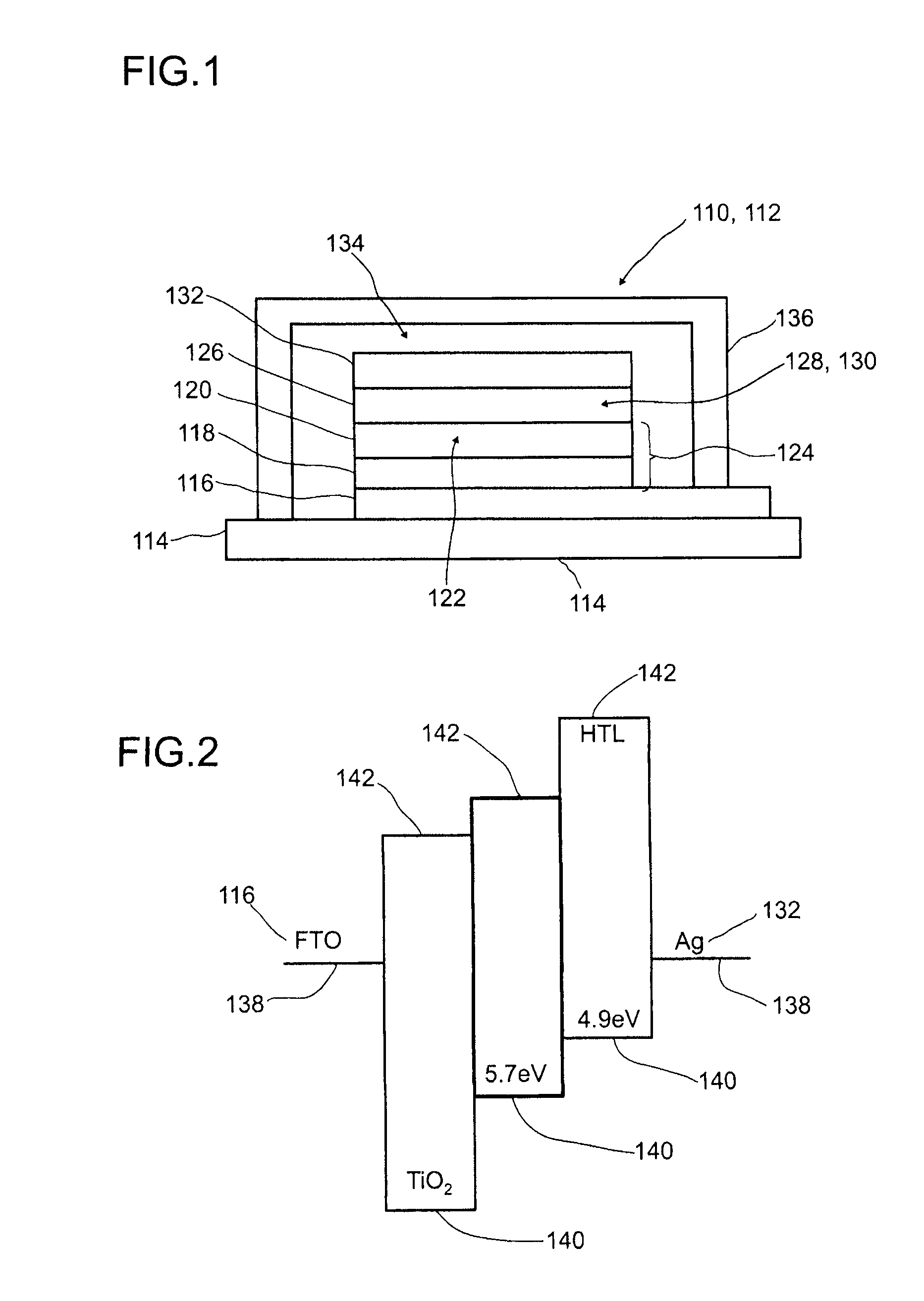Photovoltaic element
a photovoltaic element and photovoltaic energy technology, applied in the direction of photovoltaic energy generation, electrical equipment, semiconductor devices, etc., can solve the problems of high cost of technology, general limited proportion of light which can be used by dyes, and stability problems
- Summary
- Abstract
- Description
- Claims
- Application Information
AI Technical Summary
Benefits of technology
Problems solved by technology
Method used
Image
Examples
example 1
Doping with 5 mm AG-TFSI
[0216]As the first working example of an inventive photovoltaic element 110, the above-described comparative sample was modified by doping the p-semiconductor 126 or the matrix material 128 thereof with silver bis(trifluoromethylsulfonyl)imide (Ag-TFSI). For this purpose, 5 mm silver bis(trifluoromethylsulfonyl)imide (source: Aldrich) in cyclohexanone was added to the p-semiconductor solution of 0.12M spiro-MeOTAD (source: Merck) and 20 mm LiN(BO2CF3)2 (source: Aldrich) in chlorobenzene. This solution was then spun onto the sample as described for the comparative sample.
[0217]The metal back electrode as the second electrode 132 was applied immediately thereafter by thermal metal vaporization under reduced pressure. The metal used was Ag, which was vaporized at a rate of 3 Å / s at a pressure of approx. 2*10−6 mbar so as to form a layer thickness of about 200 nm.
[0218]To determine the efficiency η, the particular current / voltage characteristic was measured with ...
example 2
Variation of the Dopant Concentration
[0221]In order to study the influence of the amount of dopant on the properties of the photovoltaic element 110, variations of example 1 were additionally produced with 1-20 mm silver bis(trifluoromethylsulfonyl)imide. Otherwise, the samples were produced like the sample according to the above-described example 1. The characteristics of these samples, measured after 2 days, are shown in table 3. The illumination in these measurements was in each case again 100 sun, as already in the measurements above.
[0222]
TABLE 3Comparison of characteristics of samples according to example 2 withdifferent Ag-TFSI content.Isc[mA / cm2]Voc[mV]FF[%]ETA[%] 1 mM Ag-TFSI−10.4780534.3 3 mM Ag-TFSI−10.1780624.8 5 mM Ag-TFSI−9.8780665.010 mM Ag-TFSI−9.7760695.120 mM Ag-TFSI−9.7800644.9
[0223]The measurements show that, in terms of efficiency, a maximum of approx. 5.1% occurs at approx. 10 mm Ag-TFSI. Overall, the efficiency between 3 mm and 20 mm, however, follows a compar...
example 3
Variation of the Matrix Material
[0224]In addition, as example 3, the influence of the matrix material 128 on the properties of the photovoltaic elements 110 was studied. For this purpose, samples were produced according to the above-described example 1, except that spiro-MeOTAD as matrix material 128 was replaced by different matrix materials 128 with different concentrations, more particularly by the matrix materials of the ID522, ID322 and ID367 types already mentioned above. To introduce silver 130 in oxidized form, the dopant used was again in each case 10 mm silver bis(trifluoromethylsulfonyl)imide in all samples. The characteristics of the samples obtained in this way are shown in table 4. The specified concentrations of 160 mg / ml and 200 mg / ml are based on the concentration of the matrix material 128 in the liquid phase. The characteristics were again recorded after 2 days and measured at 100 sun [mW / cm2].
[0225]
TABLE 4Comparison of characteristics of samples according to exam...
PUM
 Login to View More
Login to View More Abstract
Description
Claims
Application Information
 Login to View More
Login to View More - R&D
- Intellectual Property
- Life Sciences
- Materials
- Tech Scout
- Unparalleled Data Quality
- Higher Quality Content
- 60% Fewer Hallucinations
Browse by: Latest US Patents, China's latest patents, Technical Efficacy Thesaurus, Application Domain, Technology Topic, Popular Technical Reports.
© 2025 PatSnap. All rights reserved.Legal|Privacy policy|Modern Slavery Act Transparency Statement|Sitemap|About US| Contact US: help@patsnap.com



